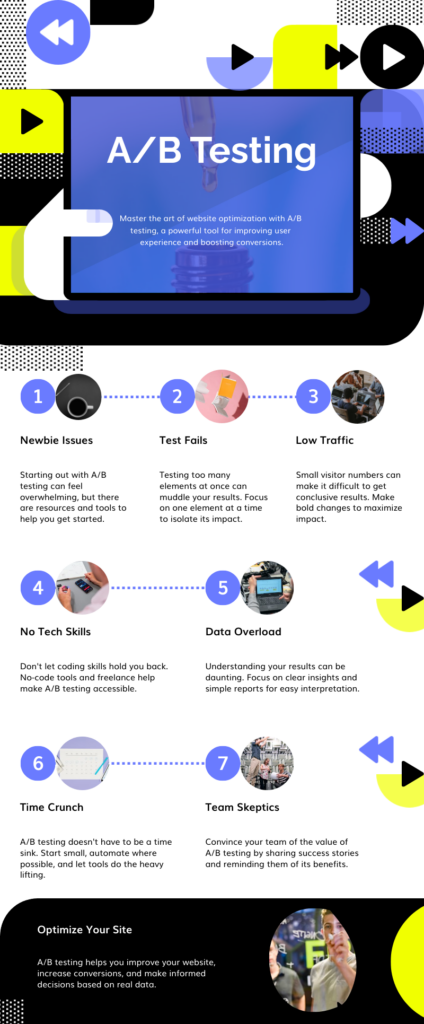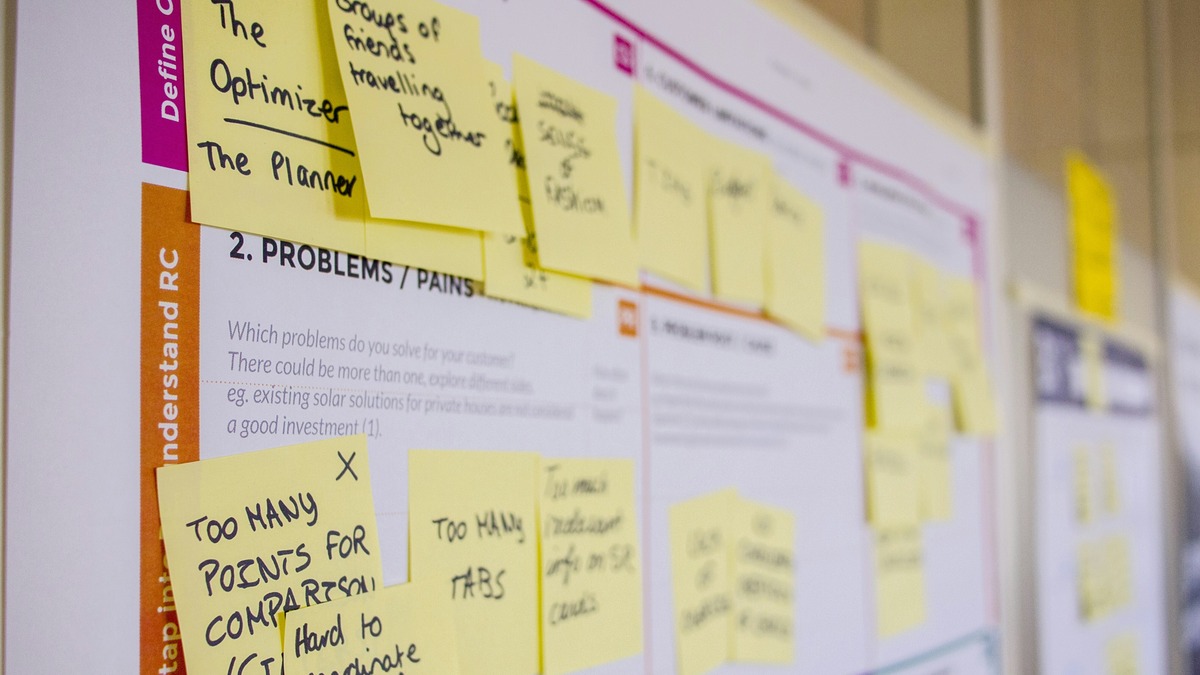A/B testing for SMEs involves a structured process to improve business outcomes. It starts by identifying a clear goal, such as increasing website clicks, boosting email sign-ups, or driving more sales.
Once the objective is set, two versions (A and B) are created with a single difference, like a headline, button color, or product image. These versions are then shown to two random halves of the audience. Results are measured using metrics like click-through rates or revenue, and the version with better performance is implemented.
For SMEs, A/B testing is valuable because it improves return on investment by focusing limited budgets on strategies that work. It minimizes risk by allowing businesses to test ideas before making costly changes. This approach supports data-driven decision-making, replacing guesswork with evidence-based insights. It also helps businesses understand customer preferences by revealing which options resonate most.
Examples of A/B testing for SMEs include optimizing website layouts to determine the most effective design or experimenting with product descriptions to increase conversions. In email campaigns, SMEs can test subject lines or call-to-action buttons to improve engagement. For ad campaigns, businesses can compare the performance of different creatives, such as images versus videos, or test promotional offers like “Free Shipping” versus “10% Off” to identify what drives more traffic and sales.
Understanding A/B Testing
Implementing A/B testing without a dedicated marketing team can be challenging but is still achievable with the right strategies. A/B testing allows businesses to optimize their digital assets systematically, even with limited resources. However, it does come with obstacles, such as a lack of expertise, poor test design, insufficient traffic, and limited technical skills. Recognizing these challenges and addressing them effectively ensures the testing process remains impactful.

One common issue is the lack of expertise, which can make it difficult to design effective tests or understand customer behavior. This can be addressed by leveraging user-friendly A/B testing platforms like Google Optimize, Optimizely, or VWO, which guide users through the setup process. Additionally, self-education through online resources, tutorials, and courses can empower small teams to build essential skills. Poorly designed tests, another hurdle, often arise when too many variables are tested simultaneously or when goals are unclear. Businesses can overcome this by testing one variable at a time, such as a headline or button color, and by defining clear KPIs (key performance indicators) like conversion rates or click-through rates to measure success accurately.
Low traffic poses another challenge, as small data sets can make achieving statistically significant results difficult. To combat this, SMEs can prioritize testing major changes that are likely to produce noticeable differences, such as a complete redesign of a landing page. Statistical tools built into platforms can also help interpret results reliably, even with smaller sample sizes. Additionally, a lack of technical skills might hinder the ability to set up tests, especially for websites or apps. This issue can be mitigated by using no-code tools like Unbounce or AB Tasty, which simplify test creation, or by hiring freelance developers for more complex tasks.
Analyzing results is another area where teams may struggle. Interpreting data and drawing actionable conclusions can feel overwhelming without analytics expertise. To simplify this, businesses can rely on tools that generate user-friendly reports highlighting key metrics and actionable insights. For instance, noting that “Version A increased sign-ups by 15% compared to Version B” provides clarity and makes implementation decisions easier. Limited resources, such as time and personnel, can further complicate testing for small teams. Starting small by focusing on high-impact areas like homepages or pricing pages and using tools that automate parts of the process, like tracking and reporting, can help save time and effort.
Finally, resistance to change can slow down the adoption of A/B testing, especially without a marketing team to advocate for it. Overcoming this skepticism requires sharing success stories from similar businesses to demonstrate tangible benefits, such as improved conversion rates or revenue growth. Framing A/B testing as a method to reduce risks and ensure data-driven decisions can also reassure stakeholders and encourage buy-in. With these strategies, even small teams can effectively implement A/B testing and unlock its full potential.
How to Run A/B Testing with a Limited Budget
Let’s dive into how a small business can make the most of A/B testing without draining its budget, using a simple example. Imagine a small online store that sells candles. They’re working with a modest budget for online ads and want to get more people to not just visit their website but actually buy something. The goal? Increase conversions—turn more visitors into customers.
Step 1: Set the Goal
First things first, they need to figure out what exactly they want to achieve. In this case, the aim is straightforward: get more people who land on the homepage to follow through and make a purchase. Essentially, they want to improve their conversion rate—so more visitors end up as paying customers.
Step 2: Create Two Versions (A and B)
With a tight budget, there’s no need for a complete redesign. Instead, the business decides to make a minor change to test its impact.
- Version A (Original): The homepage displays a big, beautiful image of the candles, paired with a “Shop Now” button. It’s the default setup, with a clean and classic navigation menu at the top.
- Version B (Variant): Here, the homepage keeps the candle image but swaps out the “Shop Now” button for a banner that says, “20% Off Your First Order.” Below it is a new CTA button that says, “Get My Discount.”
Step 3: Split the Audience
To run this A/B test without any hassle, the business uses a free tool like Google Optimize or VWO—both great for small budgets. They split their visitors into two groups, sending half to Version A and the other half to Version B. The test runs for two weeks, giving enough time to track meaningful data.
Step 4: Analyze the Results
The key metric here is conversion rate—how many visitors click the CTA and actually make a purchase. The business also looks at the click-through rate (CTR) for the “Shop Now” and “Get My Discount” buttons.
Here’s what they discover:
- Version A has a conversion rate of 2%.
- Version B, with the 20% off offer, is a clear winner, with a conversion rate of 3.5%. Plus, the click-through rate on the new CTA button is 15% higher than the original.
Step 5: Pick the Winning Version
The numbers are in, and Version B takes the prize. With a higher conversion rate and a stronger CTA response, the business decides to roll out this version permanently on the homepage.
Step 6: Budget-Friendly Approach
The beauty of this test is how budget-friendly it was. They used free tools (Google Optimize), made only minor tweaks to the homepage design (which they did themselves using an easy website builder), and didn’t need to hire any outside help. The real cost was just the time spent setting up the test and monitoring the results—which didn’t take much time for a small team. By keeping things simple and efficient, the business was able to maximize its budget and improve conversions without overspending.
Amplitude launches self-service A/B testing
Amplitude has just launched its Web Experimentation tool, a game-changer for marketers, product managers, and growth teams who want to boost conversion rates without the usual headaches. No more relying on developers for A/B testing – this tool lets you run experiments directly on your website or app with an easy, point-and-click interface. Whether you’re tweaking your homepage or testing new features, Amplitude’s Web Experimentation makes it simple to launch tests in minutes, with built-in support to guide you every step of the way.
This isn’t just for basic tests either. With advanced capabilities like sequential testing, multi-armed bandits, and customer-driven insights, you can run complex experiments that scale with your business, all while keeping your page performance fast and smooth. Plus, it’s free with Amplitude’s Starter plan, making it a perfect fit for teams of all sizes who want to accelerate their growth without waiting for engineering resources. As Adam Craig from Lendi puts it, “Amplitude Web Experimentation is a total game-changer—no more waiting around for dev teams, we can move faster and drive better conversions.”
Keep up to date with our stories on LinkedIn, Twitter, Facebook and Instagram.
A/B testing is a versatile tool that businesses can leverage to improve performance and make better decisions across various areas. Here’s how: Featured, News, A/B testing Dynamic Business








